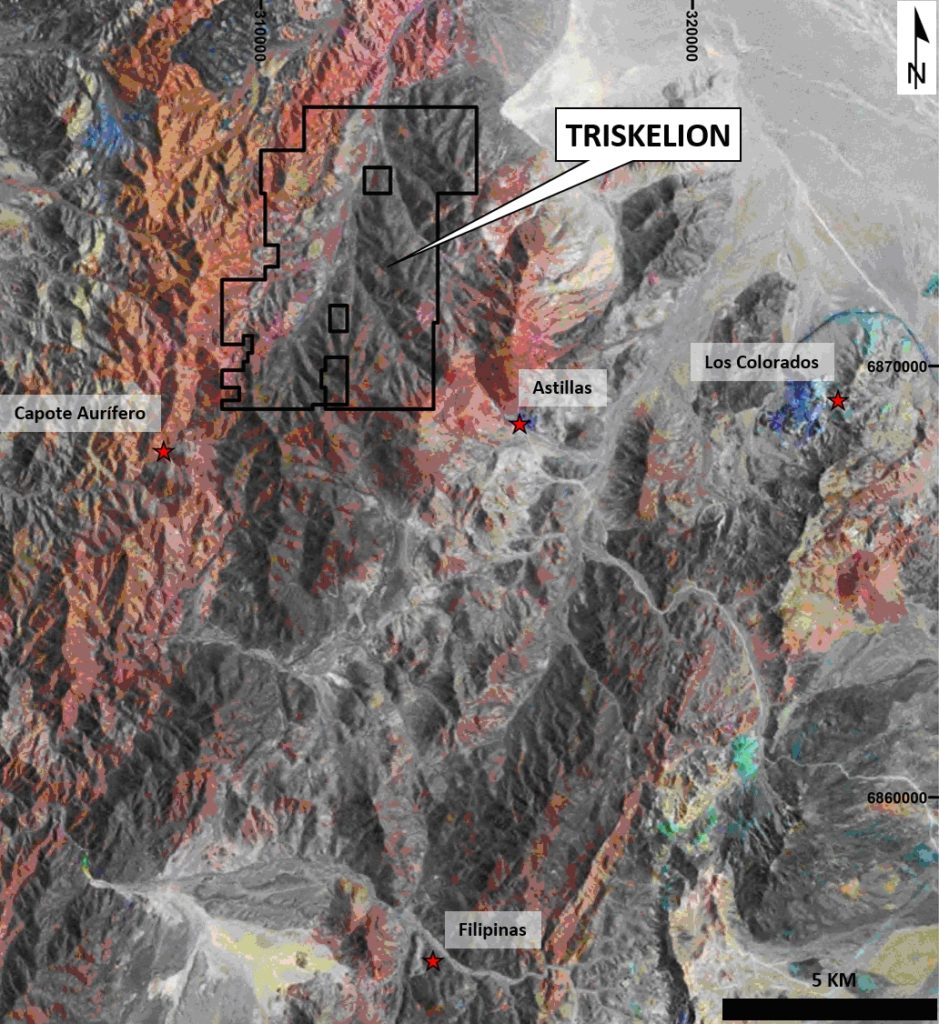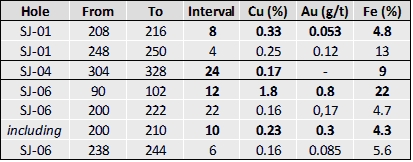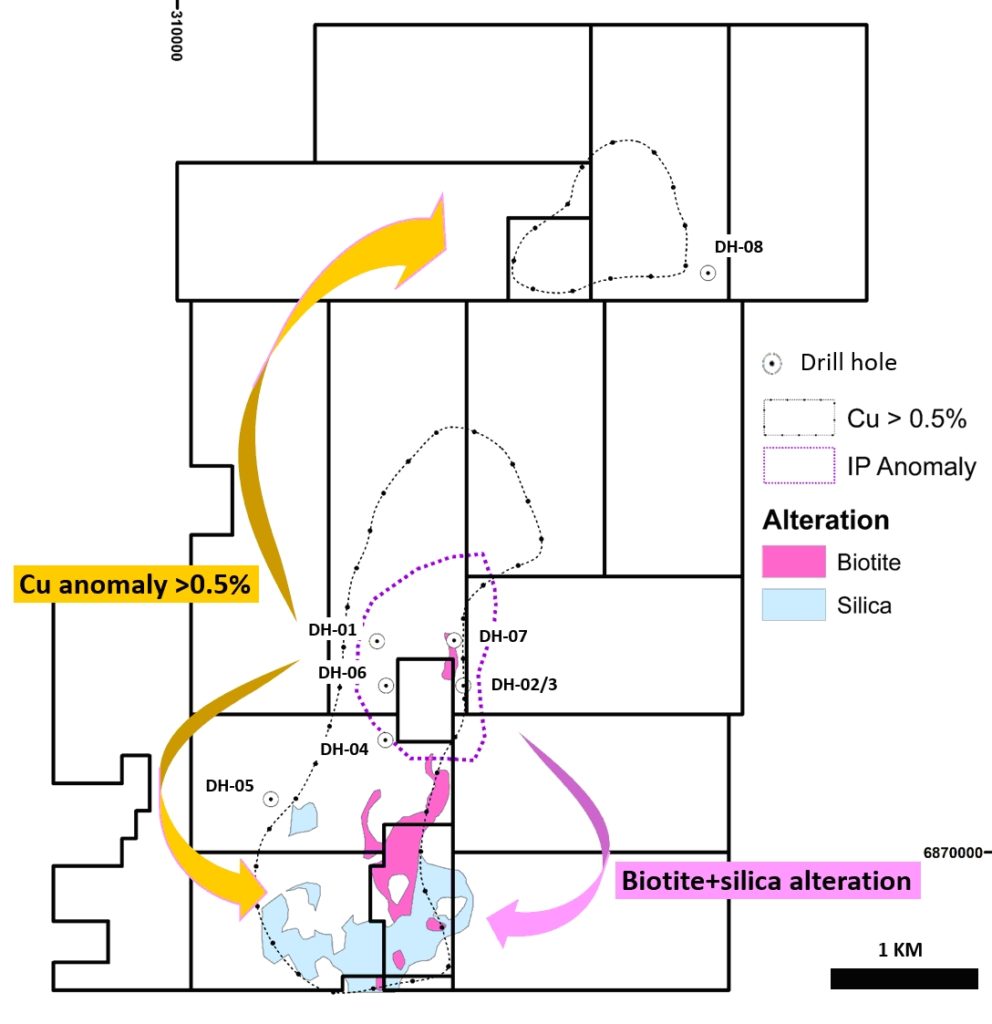Executive Summary
Triskelion is located in the coastal belt of Chile, a region known for excellent iron, copper and gold production. The project is near Vallenar city and has easy access roads. It is comprised of a solid block of exploitation and exploration properties, located in a district of IOCG and Fe-Apatite deposits. Previous drilling showed attractive Cu-Au-Fe intercepts, and the system is still open.
Key points
- 56 km from Vallenar city with good access roads.
- Mining property. 3191 ha, 100% MASGLAS.
- Exploration stage. Mapping, sampling, and partial geophysics and drilling.
- Exploration potential. Porphyry Cu-Mo, IOCG and Iron Ore.
Location
Triskelion is located in the Atacama Region of northern Chile, approximately 35 kilometers northeast of Vallenar city.
The project is located in the coastal belt, fertile with IOCG, Iron ore and Cretaceous porphyry mineralization. This district is adjacent to renowned mines and advanced exploration projects. The recent discovery at the Astillas project (AMSA, 50Mt@1% Cu), and important mines like Capote Aurífero and Los Colorados (CMP; >420Mt@ 45% Fe) are located in a 15 km area around the Triskelion project. (See Figure 1)
Other advanced exploration projects like the Filipinas (Minera Activa; 9.3Mt@0.95% Cu, 0.3 g/t Au, 19% Fe inside a Fe ore body of 51Mt @ 27% Fe, 0.12 % Cu) and Productora (Hot Chili; 214.3 Mt @ 0.48% Cu, 0.1 g/t Au & 138ppm Mo) also are part of this productive belt.

Mining Property
The mining claims block comprises 3191 ha of exploitation and exploration properties, and is 100% owned by MASGLAS.
Geology
Triskelion geology is underlain by fine‐grained andesites, ocoitic andesites, andesitic breccias and amygdaloidal andesites from the La Negra Formation. Main hydrothermal alteration includes pervasive fine actinolite, with a central zone of chlorite‐epidote. In the Southeast sector of the property biotite cutting previous actinolite, pervasive texture, and veinlets were observed. This alteration overprint is controlled by a northeast regional structure related to the Astillas and Capote deposits. The western part of the property shows strong albitisation and moderate silicification. Scapolite, epidote‐tourmaline, K‐feldespar have also been noted.
At surface there is evidence of copper mineralization hosted in north-south and northwest striking veins with magnetite‐specularite‐hematite‐atacamite‐chrysocolla, with lesser cuprite, pyrite and chalcopyrite. Associated alteration is actinolite‐chlorite with lesser quartz.
A series of coarse calcite veins with chalcopyrite were noted within the ocoitic andesite with actinolite alteration, in the southeast part of the area. Such veins are commonly found in the upper parts of IOCG systems in Chile.
Exploration
Previous exploration work at the Triskelion was carried out by Minera Inmet Chile SA. The company completed geological mapping, sampling, geophysics surveys and short drill program.
A total of 90 surface rock samples were collected. High grade Cu-Au-Fe mineralization was detected in veins and breccias, with values up to 4.46% Cu, 5.05 ppm Au, 1060 ppm Co and 49.8% Fe.
Rock samples in disseminated mineralization with biotite‐actinolite alteration in ocoitic andesites and andesite recorded results up to 0.16% Cu, 0.03 ppm Au, 13.7% Fe.
In 2012, 178 kilometers of ground magnetic survey with 100 meters spaced lines was carried out. In addition 38.3 kilometers of IP survey with the pole‐dipole array and a dipole spacing of 100 meters was completed. Both surveys were conducted by contractor Argali Geofísica Chile E.I.R.L. Geophysics shows chargeability and magnetic anomalies typical of IOCG signatures.
Subsequently, Minera Inmet Chile SA executed a short drill program of 8 mixed holes (RC/DDH) completing 2,721.2 meters. Drill holes were focused on Cu‐Au‐Fe anomaly and biotite ‐ actinolite alteration at surface. Successful results confirmed the presence of porphyry intrusions with IOCG type mineralization at depth in the Triskelion project (See Table 1).

Table 1. Main intercepts at Triskelion Project.
The best intercepts in drill hole SJ-06 are related to a diorite porphyry with magnetite-chalcopyrite-pyrite veins, and mineralization also occurs in the host rock andesites a disseminated chalcopyrite halo.
Previous exploration demonstrated that IOCG mineralization type is present at a depth of 200 meters from surface, where hydrothermal feeder with Magnetite – chalcopyrite – pyrite were intercepted in drill hole SJ-06. At surface a 6 x 1.7 kilometers area returned with Cu anomalies over 0.5%, and biotite-silica alteration extends up to 2 kilometers to the south. New exploration targets are defined by geological vectors. (See Figure 2)

As was described in the Triskelion district, high grade Cu-Au-Fe mineralization is present in the Capote Aurífero and Astillas mines. Both are related to the main structural control with northeast strike crossing the property.
MASGLAS exploration works is underway.
